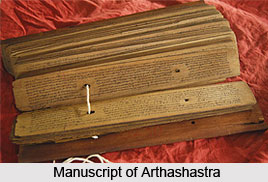 The content of Arthashastra has been divided into fifteen sections or Adhikaranas. It also has 180 subdivisions or Prakaranas. However this division is crossed by Adhyayas, which are marked by the insertion of verses that sum up the doctrine developed. The Adhikarana deals with the bringing up and education of a price. Arthashastra accepts the Brahmanical theory of the caste and their duties -economics, agriculture, pastoral pursuits, trade and industry and polity and Dandaniti.
The content of Arthashastra has been divided into fifteen sections or Adhikaranas. It also has 180 subdivisions or Prakaranas. However this division is crossed by Adhyayas, which are marked by the insertion of verses that sum up the doctrine developed. The Adhikarana deals with the bringing up and education of a price. Arthashastra accepts the Brahmanical theory of the caste and their duties -economics, agriculture, pastoral pursuits, trade and industry and polity and Dandaniti.
Structure of Arthashastra
The ministers of the king, his council, his spies, the princes of his house who, the humble people; his emissaries abroad are all described. The duties of a King are enumerated. His harem has also been elaborately described. The duties of army thereby discussing on the detailed control of administration exercised in an Indian state has also been touched upon. In the third Book III law is discussed. In book iv oppression of evil-doers by police action and heavy penalties; cheating doctors, prevent artificial increase of prices, adulteration, use of false weights have been clearly described. Book v is informative as it explains how a king can rid himself of a minister of whom he is tired. The means of extorting money was not less cleverness.
In Book VI the seven elements of politics: the king, minister, land, fort, treasure, army, and ally are described. This is followed by a formal analysis of inter-state relations carried. Book vii deals with nine probable causes of action, peace, war, neutrality, preparation to march out alliance as well as doubtful attitude. Book viii speaks about the evils that may arise from a king`s addiction to hunting, gambling, women, and drink, and the misfortunes which fire, water, or other cause may bring on a land. In Books ix and x the topic of war is dealt with, the king is provided with several tricks in order to avoid fair fight. In book xi how the king can sow disagreement in and destroy the unity of the opponent. In book xii it is mentioned how a weak king can enhance himself by keeping spies, secret agents, or with the help of women poison the food of enemy king and so on. In chapter xiii how a king can capture a fortified city.
Book fourteen is an end of the Aupanisadika, or secret part that consists of recipes to enable one to murder or cause blindness and so on. A man is taught how to make himself invisible, to see in the dark, to fast for a month and so on. How can he be unharmed through fire, to change his colour are also described. The last book speaks about the plan of the work.
Arthashastra has often been considered as a treatise on political philosophy. Throughout the author writes based on Brahmanical belief. Arthashastra accepts the existence of the three aims of life, Dharma, Artha, and Kama. According to Arthashastra Artha is the most important. However in Arthashastra the doctrine supported is that for maintenance of a firm rule, the means employed are justified. As far as means to secure obedience and to defeat enemies are concerned the Arthashastra is ruthless.
It lacks the positive quality. However Arthashastra gives us names of kings who were grieved through some way or the other. It recognizes the risks run by a king from court intrigues, military factions, false ministers and unruly heads of gilds. It recognizes him as a servant of the state.
The form of the work is a prose Sutra with Bhashya. It is a commentary. The headings of chapters are small to form the Sutra. Thus the work is a blending into one of the two elements. Verses are used occasionally though at times Tristubha are inserted and the text ends with a few verses summarizing its effect. The dryness of mere description in dogmatic form is broken here.
The language of the text is apt for the text. There are rare words that are drawn from technical science thereby the meaning is often obscure. There is shrewd effective expression and the author appears is advantageous in pithy verses.



















